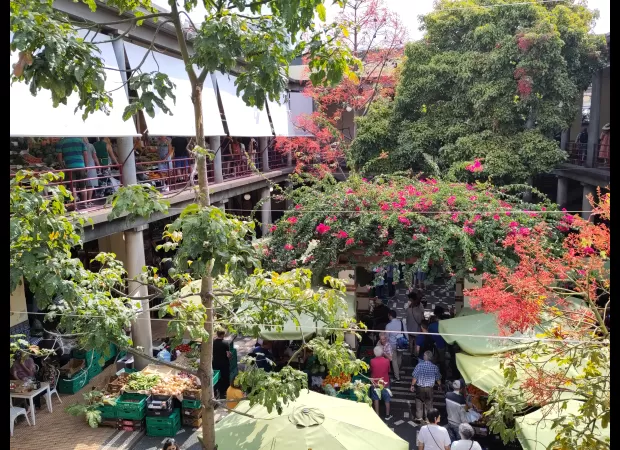Funchal, Madeira's capital, is a natural oasis close to the city.
Include these spots in your travel plans.

Every year, the Portuguese island of Madeira is filled with life and colour as a spring flower festival takes place in the capital city of Funchal. The city streets are lined with blooms, and the trees are a mix of exotic species, collected from across the world over centuries. From the balcony of the Barceló Funchal Oldtown hotel, you can take in the indigo sea below and enjoy mouth-watering food at its restaurant, Noz.
Nature is everywhere on the island, with ancient peaks and UNESCO-protected laurel forests. Wild pumpkins grow freely and the locals are generous - hikers won't go hungry! The boat journey from the airport to Funchal is accompanied by flying fish, an incredible sight.
Sofia Maul, a professional storyteller and guide, takes us to the bustling marketplace for a taste tour of the local fruits. She speaks of her family's history on the island, her grandfather's fishing and her father's invention of Briso - the island's staple soft drink. Everywhere you look, you can see people entwined with the natural world and a shared story.
We also visit Bordal, Madeira's last traditional embroidery factory. Here, the painstaking process is practiced by a dwindling number of people, and the fabric is dyed and sent to the homes of 450 women who embroider without a sewing machine. It's no wonder their work has been chosen for Chanel, and even the baby clothes of Princesses Beatrice and Eugenie.
There's plenty to do on Madeira, from the Monte Palace Tropical Garden, to the Funchal Cathedral, toboggan rides and the CR7 museum. Plus, there's a range of festivals throughout the year, from Carnivals to the International Fireworks Competition.
You can also visit Blandy's Wine Lodge and the Nini Andrades Silva Design Centre, for a free exhibition of designer Nini Andrades' work. Ivan Rodrigues offers Jeep tours of the mountains, where you can take in the forest, vineyards and banana farms. Plus, there's the chance to try the traditional Poncha, a sharp and very satisfying drink made with Madeiran rum and lime.
Finally, the rooftop bar of the Barceló Funchal Oldtown is a great place to relax with a cocktail and take in the night sky. Here, you can watch two women embroidering, hired to stitch while the DJ plays - a reminder of the area's traditions. Everywhere you look, you can see Madeira's story coming to life.
Every year, the world-renowned Spring Flower Festival takes place in the idyllic island of Madeira. Despite its small size, the Portuguese island is full of life and beauty, boasting an abundance of lush greenery, trees from all across the globe, and banana plants that produce some of the sweetest fruits. As my group arrived at the start of May, the streets were still paved with blooms, accompanied by the ancient peaks covered with UNESCO-protected laurel forests.
No one would go hungry on Madeira, as the land is generous and every farmer is known to produce good crops. This was evident during an off-road tour that exposed wild pumpkins, and flying fish that accompanied us from the airport to central Funchal. The Barceló Funchal Oldtown hotel is a charming base, with crisp local-inspired furnishings, balconies overlooking the indigo sea, and a restaurant offering some of the best ceviche I have ever tasted.
The wonder of the city doesn’t stop there. Folk dancers perform in the warm streets, and in the lush parks, locals can be seen embroidering by hand for the local clothing company. Tour guides, such as Sofia Maul, offer food and wine tours and take guests to the bustling marketplace for a taste tour of local fruits. Sofia and her family have been part of the city for generations, with her grandfather catching deep-sea fish, her father inventing the island’s staple soft drink, and Sofia teaching languages in the shade of trees she planted.
On a visit to Bordal, Madeira’s last traditional embroidery factory, I saw how the pieces for Chanel and the baby clothes of Princesses Beatrice and Eugenie were produced. The women who embroider without a sewing machine are paid by the stitch and their care and dedication does not go unnoticed.
For those looking for activities to do in Madeira, there’s the Monte Palace Tropical Garden, with an abundance of lush flora and fauna. The Funchal Cathedral marks the centre of the city, with its beautiful ceiling, and one can take a toboggan ride down the steep streets from Monte to Funchal. Wine lovers can visit Blandy’s Wine Lodge to try the island’s eponymous fortified booze, while art enthusiasts can explore the free exhibition of designer Nini Andrades’ work. Football fans can marvel at Cristiano Ronaldo’s trophies at the CR7 Museum, and those looking for a party can attend the festivals held on the island, from Carnival in February all the way to Christmas in December.
At the rooftop bar of the Barceló Funchal Oldtown, guests can enjoy a satisfyingly blue cocktail called Above The Clouds, while two women sit embroidering under the night sky. This is a reminder of the area’s traditions, and reflects how the Barceló, brand new as a hotel, used to be an embroidery factory itself.
The sense of rootedness continues further up in the mountains, where Ivan Rodrigues offers Jeep tours that take guests up an unnervingly narrow, steep road. Along the way, travellers can take in the forest, vineyards, and banana farms, and sample the local Poncha, a sharp and very satisfying concoction of Madeiran rum and lime. Up here, Madeira wine is also produced, and one can experience the tranquility of the island at the Terrabona vineyard.
A visit to Madeira is an experience like no other, with its abundance of natural beauty and its centuries-old traditions still intact. It’s the perfect place to immerse yourself in a story shared by generations.
9 Views






